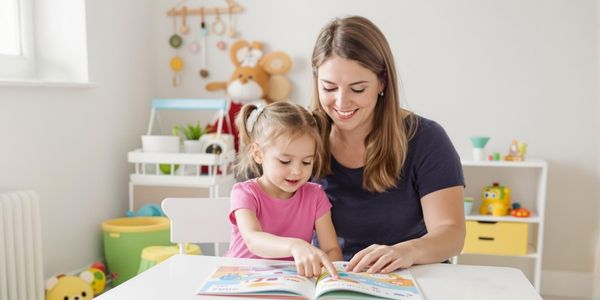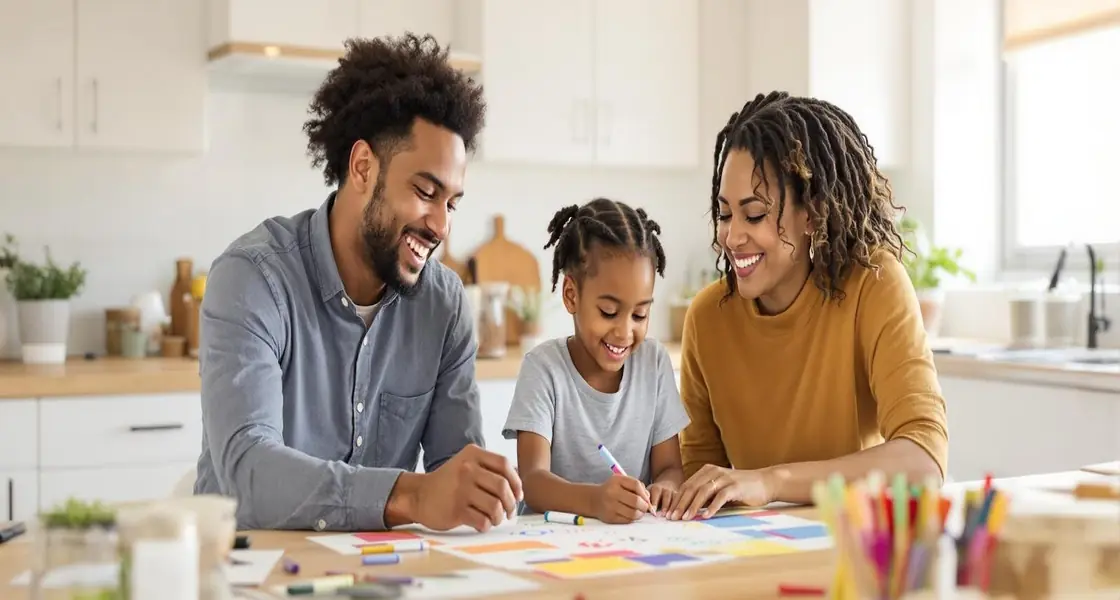Bringing kindergarten learning into your home doesn’t mean recreating a classroom. It means building days full of stories, play, and time to explore the world together. It’s a chance to enjoy how your child learns best: through curiosity and connection.
In this guide, you’ll find ideas for planning a flexible, joyful kindergarten year that grows with your child’s curiosity. We’ll share simple ways to blend play and learning, and how tools like Outschool can add connection and variety to your days together.
What’s the best kindergarten homeschool curriculum?
One of the first questions families ask is, “Which curriculum should I choose?” The honest answer is you really don't need a formal curriculum for kindergarten. At this age, learning through play and everyday experiences is often the most effective approach.
Your child builds essential skills by exploring, asking questions, creating, and simply spending time with you. Activities like building with blocks, pretending to run a store, playing outside, listening to stories, or helping in the kitchen all support early literacy, math, science, and social development, and no workbook is required.
That said, some families may feel more confident with a plan, and that’s completely valid. Kindergarten programs can provide structure for your week, especially if you’re just getting started with homeschooling. You might try a boxed curriculum that covers all the basics or pull together different resources you enjoy.
But how do you pick one that feels right for your family?
Match it to your plans
Think about what learning should feel like in your home this year, and what might come next.
For families planning to homeschool longer, it often makes sense to focus on curiosity-led learning through stories, play, and hands-on exploration. If your child will transition into a traditional school soon, you may want a light structure that introduces early reading, writing, and math in familiar ways.
Keep it simple
Free or low-cost materials are a smart way to try things out before committing to something bigger. At this stage, staying flexible and watching what sparks your child’s curiosity often leads to the best learning moments.
What sparks learning in young kids
Many kindergarteners soak up new ideas by asking endless questions, moving around, and exploring through play. Big learning moments can happen during pretend adventures, favorite stories, or hands-on activities rather than long lessons at a desk.
Some kids focus in short bursts and then need to wiggle, run, or change gears—and that’s perfectly okay. Everyday moments like reading together or counting snacks can naturally build early reading and math confidence.
Most of all, children often feel confident trying new things when they know it’s okay to make mistakes. Staying playful, listening to their questions, and weaving gentle practice into real-life moments can help keep learning fun and stress-free.
What to focus on this year
Kindergarten often balances gentle learning with plenty of space for play and discovery. After the free exploration of the preschool years, you can now introduce small steps toward more focused activities, but it doesn’t need to feel rigid.
Here are a few things to keep in mind as you shape your days:
- Follow their interests. A curious child learns naturally. Pay attention to what they ask about and let those questions guide short lessons or outings.
- Offer a variety of experiences. Books, music, nature walks, and simple art projects feed the imagination and build new vocabulary.
- Build a steady daily rhythm. Young kids thrive on a familiar flow—think stories in the morning, outdoor play before lunch, quiet time after.
- Encourage effort and curiosity. Celebrate the little things: trying again, asking big questions, or explaining an idea in their own words.
- Talk about what they learn. Connecting their play to the world around them helps ideas stick and boosts confidence in sharing what they know.
This year is about growing confidence and trust in your child's learning style. Let them wonder, play, and feel proud of their small discoveries.
Sprinkling joy into kindergarten learning
Kindergarten learning shines when playful moments and gentle structure mix naturally throughout the day. Many kids enjoy activities that feel like fun but quietly build skills in counting, early writing, and recognizing shapes. Here are a few simple areas to sprinkle into your days at home.
Playful number sense
Look for simple ways to weave counting into your day. Count how many blocks get stacked into a tower, tally snack pieces together, or number the steps from the front door to the mailbox. You can also point out bigger and smaller quantities or compare “more” and “less” during everyday activities. These little bits of number talk help build a strong, natural sense of how numbers work.
Early writing moments
At this stage, writing should feel fun and low-pressure. Invite your child to trace letters in sand or on a whiteboard, write their name on drawings, or label artwork with your help. Short, playful practice goes a long way.
Shapes and patterns
Shapes and patterns hide in everyday play. Build towers with repeating colors, hunt for circles and squares around the house, or arrange toys in simple rows. These mini activities add gentle structure to exploration.
Songs, rhymes, and movement
Music and movement keep kids engaged and help anchor early learning. Singing the alphabet or counting songs builds memory for sounds and words. Action songs, dance breaks, and fingerplays give an outlet for wiggles while practicing coordination and listening skills.
Storytelling and pretend play
Make space for your child’s imagination. Dress-up games, puppet shows, or acting out favorite stories help build language, sequencing, and creative thinking. Join in when you can—your interest makes these moments even richer.
Simple tools to keep learning fun
You don’t need a lot of fancy materials to support a fun and meaningful homeschool year. A handful of simple, flexible tools can go a long way toward blending light structure into playful days.
- A shelf of favorite books: Rotate picture books, short stories, and nature books to keep daily read-alouds fresh and interesting.
- Basic art supplies: Crayons, markers, glue sticks, and scrap paper encourage drawing, labeling, and creating at their own pace.
- Small counting objects: Small toys, buttons, or blocks help with simple math games and practicing numbers through sorting or grouping.
- Music and movement space: Leave room for dancing, singing songs with actions, or calming music to wind down after active play.
- Dress-up clothes or puppets: Props for pretend play build storytelling skills and imagination while giving you a peek into how your child makes sense of the world.
- A visual routine chart: A simple chart with pictures can help your child see what parts of the day come next, offering gentle predictability.
- A cozy, quiet spot: A beanbag, blanket fort, or pillow corner provides a calm place to read or rest when they need a break.
These ideas are just a starting point—feel free to pick and adjust based on what fits your child’s learning style and your family’s routine.
How Outschool can help on this journey
While your days at home will naturally be full of stories, play, and hands-on learning, sometimes it’s helpful to add a little extra support or variety. Outschool offers live, small-group classes that can enrich your child’s kindergarten year while giving you fresh ideas and a moment to breathe.
Here are a few ways families use Outschool to complement what they’re doing at home:
- Art and craft clubs. Guided art sessions encourage creativity and provide new projects when you want a break from planning.
- Phonics and early reading practice. Fun, interactive sessions help kids build letter sounds and early reading skills in playful ways.
- Counting and number games. Short math-focused classes turn counting and simple problem-solving into exciting mini-adventures.
- Nature and science explorations. Some families add live nature or simple science classes to feed curiosity and spark more questions to explore together.
- Connecting with other kids. Small group classes offer a friendly way for your child to interact with peers, even from home.
With Outschool, you can mix in extra support and fresh ideas whenever it makes sense for your family—no rigid schedule required. It’s one more way to keep learning light, social, and full of variety.
Frequently asked questions (FAQs)
Curious about how to make this year work best for your family? Here are a few common questions other parents wonder about when planning a flexible kindergarten year at home.
How many hours a day should I homeschool kindergarten?
Most families find that one to two hours spread throughout the day is plenty for focused activities at this age. Playtime, outdoor adventures, and daily life do a lot of the teaching, too.
Do I need a full boxed curriculum for kindergarten?
Not necessarily. Many parents piece together books, games, and activities based on their child’s interests. A boxed set can help some families get started, but it’s fine to mix and match resources.
How do I balance play and early academics?
Follow your child’s interests—sprinkle in short reading, writing, or counting moments during play and daily routines. Keep lessons light and watch for when they need a break to move or rest.
Can I homeschool kindergarten while working?
Yes, but it might take some creativity and flexibility. Many parents spread activities over early mornings, lunch breaks, or evenings. Outschool classes can also help cover topics when you need an extra pair of hands.
How should I track progress at this age?
Keep it simple: jot down notes about what your child enjoys, new things they try, or milestones they reach. Photos, saved art projects, or a journal can help you see growth over time without formal testing.
Celebrate growth through everyday learning
There’s no one-size-fits-all roadmap for teaching kindergarten at home, and that’s part of what makes it so special. By blending playful exploration with a bit of structure, you’re giving your child the freedom to learn in ways that feel natural and fun.
At Outschool, we offer live classes that can fit right into your rhythm—whether you need support with early reading, want to try a fun math club, or just need something fresh to keep the day going. It’s all about what works for your child and your homeschool path.


.svg)
.svg)







